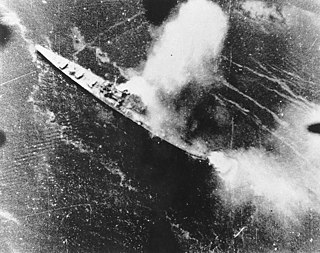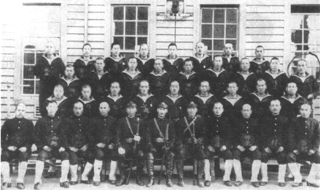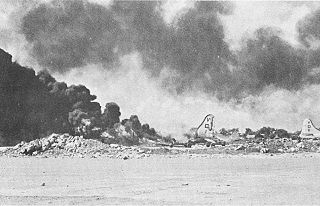
The Battle of Leyte Gulf was the largest naval battle of World War II and by some criteria the largest naval battle in history, with over 200,000 naval personnel involved. It was fought in waters near the Philippine islands of Leyte, Samar, and Luzon from 23 to 26 October 1944 between combined American and Australian forces and the Imperial Japanese Navy (IJN), as part of the invasion of Leyte, which aimed to isolate Japan from the colonies that it had occupied in Southeast Asia, a vital source of industrial and oil supplies.

Yamato (大和) was the lead ship of her class of battleships built for the Imperial Japanese Navy (IJN) shortly before World War II. She and her sister ship, Musashi, were the heaviest and most powerfully armed battleships ever constructed, displacing nearly 72,000 tonnes at full load and armed with nine 46 cm (18.1 in) Type 94 main guns, which were the largest guns ever mounted on a warship.

USS Hornet (CV/CVA/CVS-12) is an Essex-class aircraft carrier built for the United States Navy (USN) during World War II. Completed in late 1943, the ship was assigned to the Fast Carrier Task Force in the Pacific Ocean, the navy's primary offensive force during the Pacific War.

The Battle of the Philippine Sea was a major naval battle of World War II on 19–20 June 1944 that eliminated the Imperial Japanese Navy's ability to conduct large-scale carrier actions. It took place during the United States' amphibious invasion of the Mariana Islands during the Pacific War. The battle was the last of five major "carrier-versus-carrier" engagements between American and Japanese naval forces, and pitted elements of the United States Navy's Fifth Fleet against ships and aircraft of the Imperial Japanese Navy's Mobile Fleet and nearby island garrisons. This was the largest carrier-to-carrier battle in history, involving 24 aircraft carriers, deploying roughly 1,350 carrier-based aircraft.

USS Bataan (CVL-29/AVT-4), originally planned as USS Buffalo (CL-99) and also classified as CV-29, was an 11,000 ton Independence-class light aircraft carrier which was commissioned in the United States Navy during World War II on 17 November 1943. Serving in the Pacific Theatre for the entire war, taking part in operations around New Guinea, the Invasion of the Mariana Islands, the Battle of the Philippine Sea, the Battle of Okinawa, and Attacks on the Japanese home islands. After World War II's end she was converted into an anti-submarine carrier and placed in reserve on 11 February 1947.

The Battle of the Santa Cruz Islands, fought during 25–27 October 1942, sometimes referred to as the Battle of Santa Cruz or Third Battle of Solomon Sea, in Japan as the Battle of the South Pacific, was the fourth aircraft carrier battle of the Pacific campaign of World War II. It was also the fourth major naval engagement fought between the United States Navy and the Imperial Japanese Navy during the lengthy and strategically important Guadalcanal campaign. As in the battles of the Coral Sea, Midway, and the Eastern Solomons, the ships of the two adversaries were rarely in sight or gun range of each other. Instead, almost all attacks by both sides were mounted by carrier- or land-based aircraft.
This is a list of aviation-related events from 1944:

Ise was the lead ship of her class of two dreadnought battleships built for the Imperial Japanese Navy (IJN) during the 1910s. Although completed in 1917, she played no role in World War I. Ise supported Japanese forces in the early 1920s during the Siberian Intervention in the Russian Civil War. In 1923, she assisted survivors of the Great Kantō earthquake. The ship was partially modernised in two stages in 1928–1929 and 1931–1932, during which her forward superstructure was rebuilt in the pagoda mast style. Ise was reconstructed in 1934–1937, with improvements to her armour and her propulsion machinery. Afterwards she played a minor role in the Second Sino-Japanese War.

The bombing of Rabaul in November 1943 was an air attack conducted by the Allies of World War II upon a cruiser force at the major Japanese base of Rabaul. In response to the Allied invasion of Bougainville, the Japanese had brought a strong cruiser force down to Rabaul from Truk, their major naval base in the Caroline Islands about 800 miles north of Rabaul in preparation for a night engagement against the Allied supply and support shipping. Allied carrier- and land-based planes attacked the Japanese ships, airfields, and port facilities on the island of New Britain to protect the Allied amphibious invasion of Bougainville. As a result of the Rabaul raids, the Japanese naval forces could no longer threaten the landings. The success of the raid began to change the strongly held belief that carrier-based air forces could not challenge land-based air forces.

Operation Hailstone was a massive United States Navy air and surface attack on Truk Lagoon on 17–18 February 1944, conducted as part of the American offensive drive against the Imperial Japanese Navy in the Pacific Ocean theatre.

The invasion of Tulagi, on 3–4 May 1942, was part of Operation Mo, the Empire of Japan's strategy in the South Pacific and South West Pacific Area in 1942. The plan called for Imperial Japanese Navy troops to capture Tulagi and nearby islands in the British Solomon Islands Protectorate. The occupation of Tulagi by the Japanese was intended to cover the flank of and provide reconnaissance support for Japanese forces that were advancing on Port Moresby in New Guinea, provide greater defensive depth for the major Japanese base at Rabaul, and serve as a base for Japanese forces to threaten and interdict the supply and communication routes between the United States and Australia and New Zealand.

Ryūhō was a light aircraft carrier of the Imperial Japanese Navy. She was converted from the submarine tender Taigei, which had been used in the Second Sino-Japanese War. One of the least successful of the light aircraft carrier conversions due to her small size, slow speed and weak construction, during World War II, Ryūhō was used primarily as an aircraft transport and for training purposes, although she was also involved in a number of combat missions, including the Battle of the Philippine Sea.

During World War II, Allied forces conducted air raids on Japan from 1942 to 1945, causing extensive destruction to the country's cities and killing between 241,000 and 900,000 people. During the first years of the Pacific War these attacks were limited to the Doolittle Raid in April 1942 and small-scale raids on military positions in the Kuril Islands from mid-1943. Strategic bombing raids began in June 1944 and continued until the end of the war in August 1945. Allied naval and land-based tactical air units also attacked Japan during 1945.

The attacks on Kure and the Inland Sea by United States and British naval aircraft in late July 1945 sank most of the surviving large warships of the Imperial Japanese Navy (IJN). The United States Third Fleet's attacks on Kure Naval Arsenal and nearby ports on 24, 25, and 28 July sank an aircraft carrier, three battleships, five cruisers, and several smaller warships. During the same period the British Pacific Fleet attacked other targets in the Inland Sea region and sank two escort ships and several smaller vessels as well as damaging an escort carrier.

During World War II, a series of Japanese air attacks on the Mariana Islands took place between November 1944 and January 1945. These raids targeted United States Army Air Forces (USAAF) bases and sought to disrupt the bombing of Japan by Boeing B-29 Superfortress heavy bombers operating from the islands. The Japanese lost 37 aircraft during this operation, but destroyed 11 B-29s and damaged a further 43. Preparations were also made for commando raids on the bases in early and mid-1945 but these did not go ahead.

During the last weeks of World War II, warships of the United States Navy, the Royal Navy and the Royal New Zealand Navy bombarded industrial and military facilities in Japan. Most of these bombardments were conducted by battleships and cruisers, and caused heavy damage to several of the targeted factories, as well as nearby civilian areas. A major goal of the attacks was to provoke the Japanese military into committing some of its reserve force of aircraft into battle. However, the Japanese did not attempt to attack the Allied bombardment forces, and none of the involved warships suffered any damage.

Operation Kita was conducted by the Imperial Japanese Navy (IJN) during the Pacific War in February 1945. Its purpose was to return two Ise-class hybrid battleship-aircraft carriers and four escort ships to Japan from Singapore, where they had been based since November the previous year. The movement of the Japanese force was detected by the Allies, but all attempts to attack it with submarines and aircraft failed. Nevertheless, as a result of the intensifying Allied blockade of Japan, the Ise-class battleship-carriers and their escorts were among the last IJN warships to safely reach the country from the Southwest Pacific before the end of the war.

The attack on Yokosuka was an air raid conducted by the United States Navy on 18 July 1945 during the last weeks of the Pacific War. The Japanese battleship Nagato was the raid's main target, though anti-aircraft positions and other warships at Yokosuka Naval Arsenal were also attacked. Other U.S. Navy and Royal Navy aircraft struck airfields in the Tokyo area.

The South China Sea raid was an operation conducted by the United States Third Fleet between 10 and 20 January 1945 during the Pacific War of World War II. The raid was undertaken to support the liberation of Luzon in the Philippines, and targeted Japanese warships, supply convoys and aircraft in the region.
Naval historians such as Evan Mawdsley, Richard Overy, and Craig Symonds concluded that World War II's decisive victories on land could not have been won without decisive victories at sea. Naval battles to keep shipping lanes open for combatant's movement of troops, guns, ammunition, tanks, warships, aircraft, raw materials, and food largely determined the outcome of land battles. Without the Allied victory in keeping shipping lanes open during the Battle of the Atlantic, Britain could not have fed her people or withstood Axis offensives in Europe and North Africa. Without Britain's survival and without Allied shipments of food and industrial equipment to the Soviet Union, her military and economic power would likely not have rebounded in time for Russian soldiers to prevail at Stalingrad and Kursk.





















